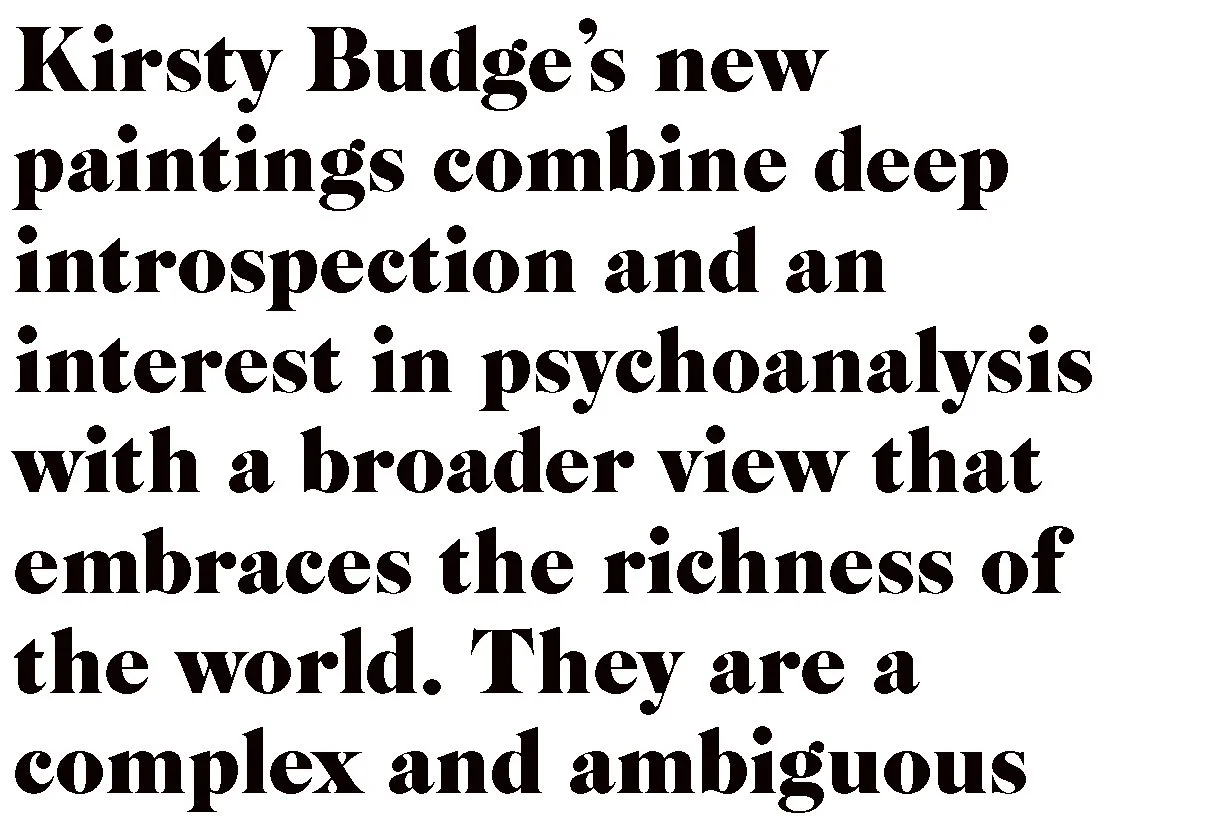Kirsty BUDGE: IF YOU’RE GONNA SPEW, SPEW INTO THIS
Kirsty Budge’s new paintings combine deep introspection and an interest in psychoanalysis with a broader view that embraces the richness of the world. They are a complex and ambiguous mix of figuration, abstraction, personal narrative and landscape.
Budge’s painting method embraces intuition, a process that the artist describes as “the intention of painting itself and the point where you break away from what you literally see, listen to what the work is doing and follow the intuitive composition emerging within the painting.”
In Budge’s process the removal of paint is equal to its application. Layering and excavation are vital to the construction of the composition, as forms that initially appear to be at the forefront of the work are actually exposed remnants of the past underpainting. This process is a metaphor for the artist’s approach to situations, problem-solving and daily life: “It’s important to me to make paintings that reference their own making in order to initiate a non-linear narrative.”
The paintings incorporate archetypal symbols and motifs (such as water, birds, snakes, ducks, hands, cats, clouds, eyes, feathers) with contemporary influences drawn from popular culture and personal experience. The resulting dialogues within each work are ambiguous and lend themselves to multiple interpretations. In making the works Budge employed dream analysis, appreciating the abstract and surreal logic of dreams. Throughout their creation Budge sought to explore the unconscious as a means to make sense of her reality. “Meaning evolved over time as I decoded symbols and made personal (anecdotal and metaphorical) connections via both conscious and unconscious feelings and experiences”. Motifs drawn from photographs, books, pop culture and life are grouped by colour palette, sensibility, value and tone, and are treated as clues for Budge as she decodes her own works whilst creating them. “There are all these synchronistic connections that have worked their way into the works, pulling from clues and “evidence” from my Homeland-like studio walls. The painting narrative starts to take shape through patience, listening to the work and forming direct and unconscious connections between the experiences and influences that I’m combining.”
Landscape elements in the work have been inspired by various travels, particularly in Paris, Dunedin and South Gippsland in Victoria. Painting later, away from nature and indoors, the light in the works became manufactured, inspired by documented past ephemeral moments of travel, landscape and connection. This play of darkness and light, and depth and perception in Budge’s painting is spatial but also metaphoric, as she increasingly delves into her own psyche through her work.
“I’ve been reading a lot of Carl Jung this year, exploring the unconscious to make sense of the various realities we are in. These paintings are little metaphysical spaces, stages or rooms that have their own logic and reality. The light and shadow might not be correct but they can exist in the painting realm. They feel like a combination of the philosophical and the biographical, I am forced to surrender and also trust myself to push through to the other side. I like the tension of the works saying many things at once but also they are just visual conversations or a study of meaning.”
“I think about a teacher at VCA saying “No one wants to see your anxiety on their wall” and it just cracks me up because it’s true but also all my paintings are about pushing through to the other side of that, the post-anxiety vulnerability enlightenment (or hangover).”
The influences of film, television and performance are evident in tone and composition of the works. Each painting has emerged to be a set, a stage or a scene — locations to explore fantasy, reality, autonomy, sexuality and desire. Budge writes, “The vulnerability of the stage, of improv or stand-up comedy especially feels similar to my process as the studio is one stage and the gallery itself feels like another. Painting feels like a performance, it is sensitive to mood and conditions and the vulnerability is what makes it both feel impossible but most rewarding to me. It feels like life or death, dying or bombing on stage is real, it happens and it’s devastating or it works and it’s liberating.”
Titles for works are often drawn from movies and television, and also Budge’s own life. “Each title of the paintings I can see now is a dialogue and that’s because each work is also a conversation with myself and also with painting as a process of thinking and living.” In mining pop culture, Budge is able to project the personal onto external avatars, using their dialogue and actions as a means to explore her and others’ actions and thoughts, as well as to reconnect with influential moments from her early years. “Lines from movies during that time still resonate with myself and other people and it’s a dialogue that feels weirdly relevant now in this weird time warp. It’s always a way to connect and share. Pop culture and entertainment have always informed how we act in culture and provides access to necessary conversations.” Budge describes a “thin line between dumb and profound” in her use of quotation. Perhaps her most apt title is then: “It’s like, life”.

